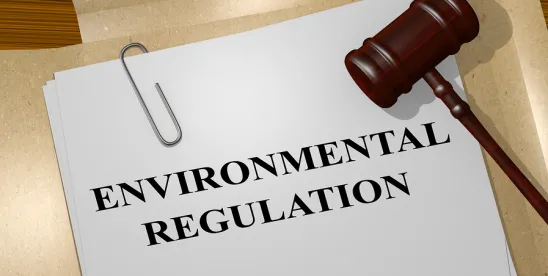Late Sunday, President Trump signed into law H.R. 133, the legislative package containing Coronavirus relief, the Fiscal Year 2021 Omnibus bill, and the Energy Act of 2020—the largest energy package to be enacted into law in over a decade. This sweeping legislation, nicknamed the “Coronabus,” contains a number of climate-related provisions, including those outlined below.
Hydroflurocarbons Phasedown
The package includes a compromise deal to wind down hydrofluorocarbons (HFCs) over a 15-year period, under a program administered by the United States Environmental Protection Agency (EPA). This is the first legislation mandating a national phasedown of HFCs, although the EPA has overseen similar programs for other greenhouse gas emissions. The bill requires a reduction of HFC production and consumption to approximately 15 percent of their 2011-2013 level by 2036, and includes a narrow provision preempting new state regulations during a five-year period. The agreement is arguably the most significant climate legislation to head to President Trump’s desk during his administration. The agreement is the result in bipartisan negotiations lead by Sens. Tom Carper (D-DE), John Kennedy (R-LA), and John Barrasso (R-WY). The deal may provide a roadmap for bipartisan climate legislation between the 117th Congress and Biden administration.
Clean Energy Tax Incentives
The Coronabus includes a section extending or making permanent a variety of tax incentives, including the following energy tax incentives.
179D Energy Efficient Commercial Buildings Deduction
This tax deduction for energy efficiency improvements to commercial buildings is made permanent, with an update to the American Society of Heating, Refrigerating and Air-Conditioning Engineers ASHRAE standard and indexing the deduction for inflation.
45Q, Carbon Oxide Tax Credit
Extends the 45Q tax credit for facilities that begin construction by the end of 2025. 45Q is a per ton credit for oxides of carbon that are captured and sequestered or utilized.
Production Tax Credit (PTC)
The PTC is extended to cover projects that commence construction by the end of 2021. Note that for wind facilities where construction begins by the end of 2021, the credit continues to be reduced by 40 percent.
Investment Tax Credit (ITC)
ITC is extended at 26 percent for solar energy property, fiber-optic solar equipment, fuel cell property, and small wind energy property that begin construction by the end of 2022; and at a 22 percent rate for property that begin construction by the end of 2023, after which the credit is reduced to 10 or 0 percent. The provision extends the 10 percent investment credit for microturbine property, geothermal heat pumps, and combined heat and power property that begins construction through 2023.
ITC for Waste Energy Recovery
ITC is expanded by adding waste energy recovery property eligibility. Waste energy property that begins construction after 2021 or 2022 is eligible for a 26 percent credit, and property that begins construction in 2023 is eligible for a 22 percent credit.
ITC for Offshore Wind
Extends the investment tax credit for electing offshore wind facilities that begin construction through 2025. Additionally, offshore wind facilities that begin construction during 2017 to 2025 are not subject to the onshore-wind facilities phase-out rates and are eligible for the full credit amount.
Second Generation Biofuel Producer Credit
Extends, through 2021, the US$1.01-per-gallon nonrefundable income tax credit for second generation biofuel sold at retail into the fuel tank of a buyer’s vehicle, or second generation biofuel mixtures sold or used as a fuel.
Nonbusiness Energy Property
The provision extends through 2021, a credit for purchases of nonbusiness energy property. The provision allows a credit of 10 percent of the amounts paid or incurred by the taxpayer for qualified energy improvements to the building envelope (windows, doors, skylights, and roofs) of principal residences. The provision allows credits of fixed dollar amounts ranging from US$50 to US$300 for energy-efficient property including furnaces, boilers, biomass stoves, heat pumps, water heaters, central air conditioners, and circulating fans, and is subject to a lifetime cap of US$500.
Qualified Fuel Cell Motor Vehicles
A credit for purchases of new qualified fuel cell motor vehicles is extended through 2021. The provision allows a credit of between US$4,000 and US$40,000, depending on the weight of the vehicle.
Alternative Fuel Refueling Property Credit
This credit is extended through 2021 and can be used for the installation of alternative fuel vehicle refueling property. The credit is capped at US$30,000 per location for business property and US$1,000 for property installed at a principal residence.
Two-Wheeled Plug-In Electric Vehicle Credit
A 10 percent credit for highway-capable, two-wheeled plug-in electric vehicles is extended through 2021.
Energy Efficient Homes Credit
This credit for new energy efficient homes is extended through 2021.
Excise Tax for Alternative Fuels
The US$0.50-per-gallon excise-tax credit or payment for alternative fuel and US$0.50-per-gallon credit for alternative fuel mixtures is extended through 2021.
Residential Energy-Efficient Property Credit and Inclusion of Biomass Fuel Property Expenditures
The package extends, through 2022, the credit for residential energy efficiency property at the current 26 percent rate for property placed in service through 2022, with the rate reduced to 22 percent for property placed in service in 2023.
Carbon Capture, Utilization, and Storage (CCUS)
Carbon Capture Technology Program
The legislation includes a Carbon Management title, with a number of provisions to advance CCUS including authorization of a Carbon Capture Technology Program within Department of Energy’s Fossil Energy Office to manage the development of transformational technologies to reduce emissions in the fossil fuel industry as well as manufacturing and industrial facilities using:
- Research and development;
- Large- and small-scale pilot projects and demonstrations; and
- A front-end engineering and design program.
Six CCUS Demonstration Projects
CCUS demonstration projects authorized in the Coronabus will be chosen through a competitive process by the Department of Energy, which will enter into cooperative agreements with industry and other stakeholders for the construction and operation of six demonstration projects for carbon capture at coal electric generating facilities, natural gas electric generating facilities, and industrial facilities.
Carbon Utilization Research, Development and Demonstration (RD&D)
The law also authorizes a carbon utilization research, development, and demonstration program to identify and assess novel uses of carbon and carbon oxides for commercial and industrial products and other products with market value.
Direct Air Capture Investment
A separate Carbon Removal Title authorizes federal investments in research, development, and demonstration of technologies and strategies for removing carbon from the atmosphere at large scale. For this program, the Secretary of Energy is directed to work with the Secretary of Agriculture because of the potential for direct air capture using agricultural processes.
The Energy Act of 2020, which was advanced as part of the larger Coronabus package, includes additional sections regarding energy efficiency, advanced nuclear energy, renewable energy and storage research and development, critical materials, and grid modernization. See here for a section-by-section of the Energy Act of 2020.







 />i
/>i
